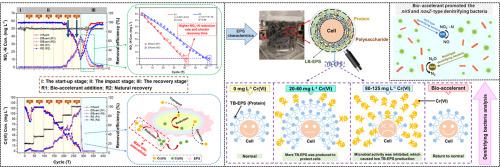Journal of Hazardous Materials ( IF 12.2 ) Pub Date : 2021-01-08 , DOI: 10.1016/j.jhazmat.2021.125087 Xu Zhou , Siyuan Zhai , Yingxin Zhao , Duo Liu , Qian Wang , Min Ji

|
Hexavalent chromium (Cr(VI)) may inhibit denitrification in biological wastewater treatment systems, and the inhibited denitrification process is difficult to recover in a short time. This study explored Cr(VI) cascade impact (20–125 mg L−1) on denitrification and developed one nontoxic biological accelerant (combination of L-cysteine, flavin adenine dinucleotide, biotin and cytokinin) for denitrification recovery. The results showed that NO3−-N removal efficiency decreased from 75.7% to 21.5% when Cr(VI) concentration increased from 80 to 125 mg L−1. Addition of accelerant could effectively promote the removal of NO3--N, and observably reduce the recovery time (42 T) compared with natural recovery (63 T). Furthermore, the main site of Cr(VI) reduction and Cr(III) immobilization was located in the intercellular compartment of the biofilm. Microbes produced more tightly bound extracellular polymeric substances (TB-EPS) to protect them from toxicity under the low Cr(VI) concentrations, while low EPS was secreted when Cr(VI) concentration was higher than 60 mg L−1. Compared to natural recovery system, bio-accelerant addition was beneficial to the recovery of denitrifiers activities, especially for the bacteria containing nirS gene. The results facilitated an understanding of Cr(VI) impact on denitrification, and the proposed bio-accelerant can be potentially applied to heavy metal shock-loading emergency situations.
中文翻译:

生物促进剂通过级联Cr(VI)暴露快速恢复抑制的反硝化作用:铬分布,EPS成分和反硝化群落的表征
六价铬(Cr(VI))可能会抑制生物废水处理系统中的反硝化作用,被抑制的反硝化过程很难在短时间内恢复。这项研究探讨了六价铬(VI)级联对反硝化的影响(20–125 mg L -1),并开发了一种无毒的生物促进剂(L-半胱氨酸,黄素腺嘌呤二核苷酸,生物素和细胞分裂素的组合物)用于反硝化恢复。结果表明,当Cr(VI)浓度从80 mg L -1增加到125 mg L -1时,NO 3 -- N的去除效率从75.7%降低到21.5%。添加促进剂可有效促进NO 3的去除--N,与自然恢复(63 T)相比,恢复时间明显减少(42 T)。此外,Cr(VI)还原和Cr(III)固定的主要位点位于生物膜的细胞间区室。微生物产生更紧密结合的细胞外聚合物质(TB-EPS),以保护它们在低Cr(VI)浓度下免受毒性作用,而当Cr(VI)浓度高于60 mg L -1时,则分泌低EPS 。与自然回收系统相比,添加生物促进剂有利于反硝化剂活性的恢复,特别是对于含有nirS的细菌基因。结果促进了对六价铬对反硝化的影响的理解,拟议的生物促进剂可潜在地应用于重金属冲击负荷紧急情况。











































 京公网安备 11010802027423号
京公网安备 11010802027423号